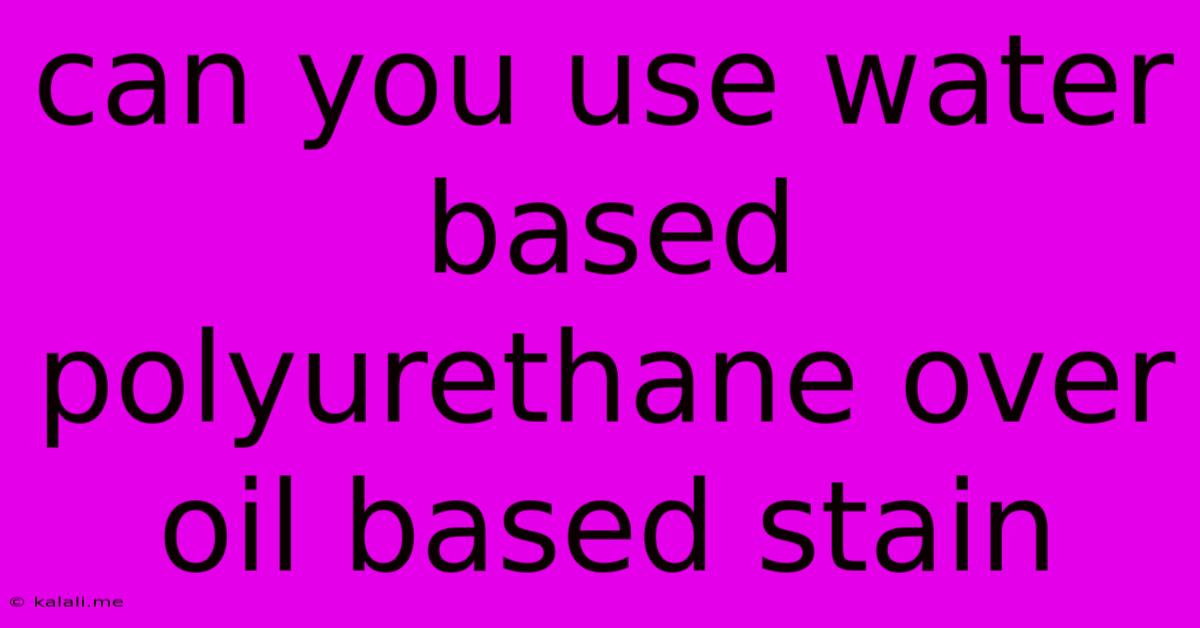Can You Use Water Based Polyurethane Over Oil Based Stain
Kalali
May 23, 2025 · 4 min read

Table of Contents
Can You Use Water-Based Polyurethane Over Oil-Based Stain? The Definitive Guide
Meta Description: Wondering if you can apply water-based polyurethane over an oil-based stain? This comprehensive guide explores the compatibility, potential problems, and best practices for achieving a durable and beautiful finish on your woodworking projects. Learn about preparation, application techniques, and troubleshooting common issues.
Applying a protective finish to your woodworking projects is crucial for longevity and beauty. Choosing the right combination of stain and polyurethane is key. A common question among DIY enthusiasts is whether water-based polyurethane can be applied over an oil-based stain. The short answer is: generally yes, but with careful preparation. This article will delve into the details, providing you with the knowledge to make an informed decision and achieve a flawless finish.
Understanding the Chemistry: Oil vs. Water-Based Products
Before we address the compatibility, let's understand the fundamental differences between oil-based and water-based products. Oil-based stains penetrate deep into the wood, creating a rich, durable color. They contain solvents that require significant drying time and often emit strong fumes. Water-based stains, on the other hand, are less pungent, dry faster, and are considered more environmentally friendly.
Water-based polyurethane is also a popular choice due to its low odor, easy cleanup with soap and water, and relatively fast drying time. However, its compatibility with oil-based products requires attention.
The Challenge: Adhesion and Compatibility
The primary concern when using water-based polyurethane over oil-based stain is adhesion. Water-based polyurethane relies on the wood's surface to adhere properly. An oil-based stain, being highly penetrating, can create a barrier that prevents optimal bonding. If the adhesion is poor, the polyurethane may peel, chip, or otherwise fail prematurely.
Achieving Success: Essential Preparation Steps
To successfully apply water-based polyurethane over oil-based stain, meticulous preparation is paramount. Follow these steps:
-
Thorough Drying: Ensure the oil-based stain is completely dry. This is crucial. The manufacturer's recommended drying time should be significantly exceeded – often a minimum of several days or even a week, especially in humid conditions. Insufficient drying time is a leading cause of failure.
-
Light Sanding: Lightly sand the stained surface with fine-grit sandpaper (220-320 grit). This will help to slightly roughen the surface, improving adhesion. Be gentle to avoid removing the stain.
-
Cleaning: Remove all sanding dust with a tack cloth or a soft brush. Any dust particles remaining will compromise the finish.
-
Degreasing (Optional but Recommended): Use a tack cloth or a clean rag to remove any remaining oil residue from the surface. This extra step ensures that the surface is as clean and ready for the polyurethane as possible.
Application Techniques for Optimal Results
Once the surface is fully prepared, you can begin applying the water-based polyurethane.
-
Thin Coats: Apply multiple thin coats rather than one thick coat. This allows for better penetration and reduces the risk of runs or drips.
-
Even Application: Use a high-quality brush, roller, or sprayer for even application. Avoid excessive brushing, which can create brush marks.
-
Proper Ventilation: Even though water-based polyurethane is low-odor, good ventilation is still recommended.
-
Drying Time: Allow each coat to dry completely before applying the next. This typically takes several hours, but check the manufacturer's instructions for the precise drying time.
Troubleshooting Common Issues
Despite careful preparation, some issues might arise. Here are a few troubleshooting tips:
-
Peeling or Chipping: This usually indicates insufficient drying time of the stain or poor adhesion. You may need to sand and reapply the polyurethane.
-
Uneven Finish: This can be due to uneven stain application, sanding inconsistencies, or dust particles.
-
Runs or Drips: This usually indicates applying coats that are too thick.
Conclusion
While applying water-based polyurethane over oil-based stain is possible, it requires careful preparation and meticulous application. By following these steps, you can significantly increase your chances of achieving a beautiful, durable finish that will enhance your woodworking project for years to come. Remember, patience and attention to detail are key to success. Always refer to the specific instructions provided by the manufacturers of both your stain and polyurethane.
Latest Posts
Latest Posts
-
Lwc Record Edit Form Bring Up Old Version
May 23, 2025
-
Furnace Shuts Off Before Reaching Temperature
May 23, 2025
-
1 X 1 X Power Series
May 23, 2025
-
How To Align Equation To Left In Latex
May 23, 2025
-
Why Does Svm Take So Long
May 23, 2025
Related Post
Thank you for visiting our website which covers about Can You Use Water Based Polyurethane Over Oil Based Stain . We hope the information provided has been useful to you. Feel free to contact us if you have any questions or need further assistance. See you next time and don't miss to bookmark.